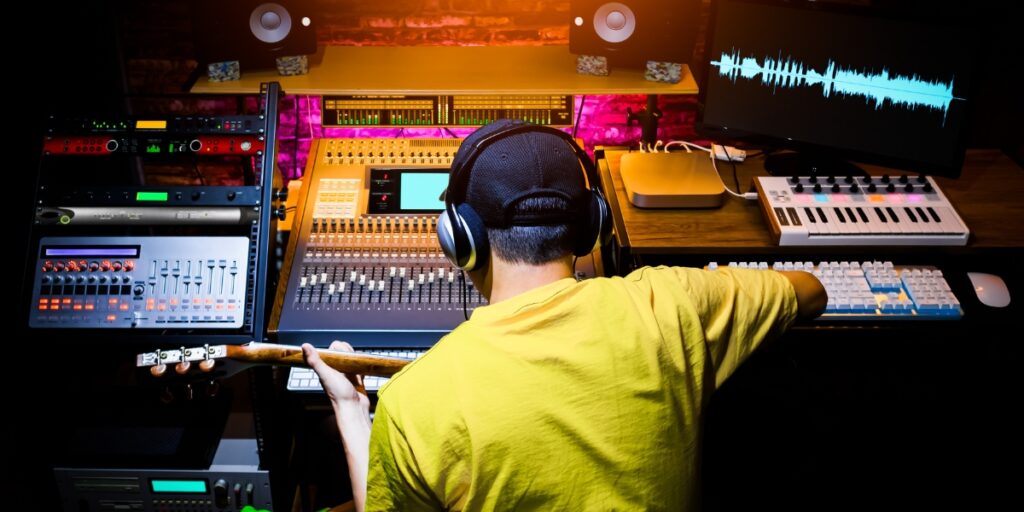If your acoustic guitar tracks are crucial to your song, applying a good EQ mix is important to make them shine.
Mastering the art of EQing acoustic guitar can be a transformative skill that adds unparalleled depth and clarity to your project. In this brief guide, we will take a look at how to EQ acoustic guitar with some tips to help refine your six-string sound!

The Importance Of A Good Acoustic EQ Mix
Creating a polished and defined acoustic guitar sound in your mix requires a thoughtful EQ mix tailored to your track. The acoustic guitar is an instrument of nuance and must be treated as such when it comes to EQing. Given its dynamic frequency range, balancing the low-end warmth, the midrange presence, and the sparkling highs requires meticulous precision.
Additionally, the guitar’s interaction with the surrounding environment can introduce complexities, necessitating careful consideration of room acoustics and mic placement during EQ adjustments.
Ultimately, creating a good acoustic guitar eq will ensure that the track occupies a clearly defined space within the greater mix without clashing with other tracks. But what does that mean exactly?
Before we start EQing, we first need to understand the intricate landscape of the frequency spectrum and how it can be used to shape your acoustic guitar sound.
Understanding The Frequency Spectrum
Think of the frequency spectrum as a painter’s palette, with each color representing a unique range of audio frequencies. In the context of acoustic guitar, this spectrum spans from the deep, resonant lows that lend body to the sound through the expressive midrange frequencies that capture the heart of the instrument’s timbre all the way to the sparkling highs that add brilliance and character.
Understanding these frequency ranges allows you to make informed EQ decisions.
For instance, boosting the lower frequencies can enhance the guitar’s warmth, while highlighting the midrange might emphasize its projection and intricate details. By sculpting these ranges, you’re essentially tailoring the guitar’s sonic personality to your creative vision.
This knowledge enables you to navigate the intricacies of the frequency spectrum with precision, ensuring that your acoustic guitar finds its rightful place in the sonic landscape of your mix.
Identifying Critical Frequency Bands for Acoustic Guitar
Honing in on specific frequency zones allows you to make informed decisions that enrich your mix and get the most out of your track.
Here are the recommended frequency ranges for effective acoustic guitar EQ:
- Highs (3kHz – 20kHz): Boosting or cutting this range can enhance your overall clarity and depth.
- Mids (200Hz – 2kHz): Managing your mids helps create a feeling of punchiness and presence within your mix.
- Low Mid/Upper Bass (50Hz – 200Hz): This range is where you can tailor your sound’s overall warmth and body. This range is crucial for re-creating an excellent acoustic tone.
- Low End (20Hz – 50Hz): Refine the lower range for precise definition and to clear up any muddiness within your mix.
The more you are familiar with these frequency ranges, the easier it will be to dial in your sound as needed. Knowing how these ranges affect your sound is essential because different situations may require different approaches.
For instance, EQing nylon string acoustic guitar will require different EQ settings than steel string tracks. This is because the inherent tonal characteristics of nylon and steel strings result in distinct frequency emphasis and resonance patterns.
Preparing Your Recording Environment For Recording
Before you can begin to EQ your acoustic track, you need to ensure you have an optimal recording space to capture your performance. Proper room treatment minimizes unwanted reflections and resonances, laying a clean foundation for EQ adjustments.
Adequate mic placement and isolation prevent environmental interference, ensuring precise tonal capture. We also recommend using the best audio interface you can access, which can further help preserve the acoustic guitar’s nuances during the recording process.
On the other hand, recording with the best acoustic pickup you can get your hands on can improve your ability to capture the subtleties of your performance. This precision ensures a faithful representation of the performance and provides a solid foundation for EQ adjustments, enabling you to sculpt the sound during the mixing stage accurately.
Recording your tracks within a controlled setting lays the foundation for consistent results, which is essential for shaping EQ during the mixing phase.
How To EQ Acoustic Guitar (5 Tips)
Let’s look at a few practical tips to help guide you when it comes time to eq your acoustic guitar tracks.
#1) Sculpting Low Frequencies for Richness
Start by addressing the low frequencies (typically around 80Hz and below). Boosting these regions slightly can add warmth and depth to your acoustic guitar, but be cautious not to overwhelm the mix.
Cutting frequencies in this range helps clear up any muddiness in the mix.
#2) Enhance Your Midrange Presence
The midrange (around 200Hz – 2kHz) is where the heart of your acoustic guitar resides. To enhance its presence, consider gentle boosts in the mid frequencies.
This can lend power and projection to the sound, making it more audible in the mix.
#3) Don’t Forget To Tame Those Harsh High Frequencies
Higher frequencies (around 2kHz – 5kHz) can bring out the attack and sparkle in your acoustic guitar. However, excessive presence in this range might lead to harshness.
Use subtle cuts to tame any sharpness without losing clarity.
#4) Refining the Overall Acoustic Mix
When it comes to refining the overall acoustic mix, your goal is to create a seamless sonic blend that lets the acoustic guitar shine without overpowering other elements. To achieve this, follow these steps:
Begin by soloing the acoustic guitar track to assess its tonal qualities independently. Listen closely for any clashes or imbalances in the frequency spectrum. Are there areas where the guitar competes with vocals, drums, or other instruments?
Next, apply subtle adjustments to the frequency bands that need refining. A parametric EQ is a powerful tool for this task. Consider areas where the guitar might sound too pronounced or lost in the mix. Remember that your adjustments should be incremental – minor tweaks often yield the best results.
#5) Balancing Your EQ Settings For Maximum Clarity
As you work, constantly compare the acoustic guitar with other tracks in your mix. This A/B comparison helps you identify frequency clashes and imbalances more accurately.
Pay special attention to areas where the guitar might be masking vocals or clashing with other instruments.
Panning the acoustic guitar slightly left or right can also create space in the center for other key elements. This technique prevents masking and ensures the guitar’s tonal nuances are heard clearly.
Once you are done mixing your tracks, you’ll need to get it professionally mastered. Landr has one of the best AI mastering tools on the market that you can use.
Closing Thoughts On EQing Acoustic Guitar
As we have seen here, achieving an exceptional acoustic guitar sound demands a nuanced approach to EQing.
Balancing warmth, presence, and clarity is essential. Understanding the frequency spectrum and its impact on sound empowers precise adjustments. Additionally, crafting an optimal recording environment and utilizing quality equipment, like a reliable audio interface and acoustic pickup, is crucial.
Implementing these EQ tips, from enhancing low frequencies for richness to refining the overall mix, refines your guitar’s place in the sonic landscape. Hopefully, this guide for how to EQ acoustic guitar equips you with everything you need to know to harness the full potential of your acoustic guitar tracks and elevate your music production.
Looking to take your productions to a professional level for a fraction of the price?
SoundShockAudio offers a directory of over 4,000 of the best free music production tools, eliminating the need for exhaustive searching in Google. For just $3/month, this platform unites top-notch quality and convenience, empowering producers to craft exceptional soundscapes effortlessly.





